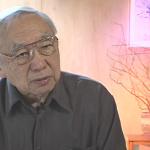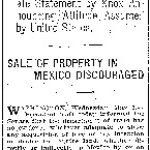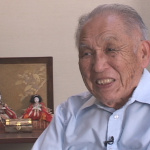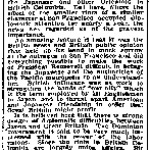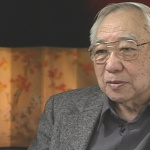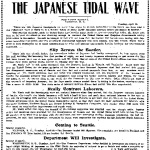Immigration Act of 1924
Also known as the Johnson-Reid Act, the Immigration Act of 1924 ended further immigration from Japan, while restricting the number of immigrants to the U.S. from southern and eastern Europe. Echoing the phrase, "aliens ineligible for citizenship," from the Alien Land Law of 1913 and the 1922 Supreme Court decision in Ozawa v. United States , a special anti-Japanese provision was inserted to exclude the Japanese who were barred from naturalization.
Background of the Legislation
Following the Red Scare of 1919, widespread fear of radicalism fueled anti-foreign sentiment and exclusionist demands. Supporters of immigration legislation stressed recurring themes: Anglo-Saxon superiority and foreigners as threats to jobs and wages.
Congress responded to nativist pressure with the Immigration Act of 1924 by setting quotas at 2 percent of each nationality residing in the United States in 1890. The law was aimed primarily at Jews, Italians, Slavs, and Greeks, who had immigrated in large numbers after 1890, but it also targeted the Japanese whose entry had been previously regulated solely through non-legislative measures. [1]
The central figures behind the act's anti-Japanese provision were The Sacramento Bee' s former publisher, V.S. McClatchy ; former California Senator James D. Phelan ; and Attorney General of California Ulysses S. Webb. During their lobbying campaign in Washington D.C., McClatchy accused the Japanese of violating the Gentlemen's Agreement , citing the picture brides ' steady arrival. He called attention to their supposed unassimilability, "astronomical birth rate," and "increased landholding" as menaces to California's Anglo-Saxon civilization. He continued, "They come here specifically and professedly for the purpose of colonizing and establishing here permanently the proud Yamato race." He singled out the Japanese among other races ineligible to citizenship, as a population who "naturally make more dangerous competitors in an economic way." [2]
On the opposite side of the spectrum was Sidney Lewis Gulick, a Congregational missionary who had lived for many years in Japan. As executive secretary and organizer of the National Committee for Constructive Immigration Legislation, he lobbied for a quota immigration bill that would "put a check on Russian, Austrian, and Italian immigration," without specifically discriminating against the Japanese. [3] Some thought that the Senate, unlike Congress, would approach the exclusionary bill with caution to maintain cordial relations with Japan. Meanwhile, the State Department and the Japanese Foreign Ministry scrambled to seek a diplomatic solution to eliminate the exclusionary clause.
One complaint that emerged out of the debates in both houses was that the terms of the Gentlemen's Agreement, based on "secret" correspondence between the U.S. and Japanese governments, were not widely known. At the request of Secretary of State Charles Evans Hughes, the Japanese ambassador, Masanao Hanihara furnished a letter on April 10, 1924, outlining the agreement and offering Japan's explanations for opposing the bill. Hughes transmitted it to the Senate the following day. [4]
Hanihara's letter marked a turning point in the exclusionist campaign. His now infamous quote, "I realize, as I believe you do, the grave consequences which the enactment of the measure retaining the particular provision would bring" was conveniently interpreted as a "veiled threat," in the words of Massachusetts Senator Henry Cabot Lodge, and thrust the bill through the Senate. On May 24, 1924, President Calvin Coolidge signed the bill into law after Congress rejected his request to delay the implementation of exclusion. This was an election year and Coolidge was not about to risk both Western and Southern support by vetoing the bill. [5]
Aftermath to Exclusion
The act aroused considerable anger in Japan. Upon its passage, both Hanihara and American ambassador to Japan Cyrus E. Woods resigned in protest. As Hanihara argued in his letter to the U.S. secretary of labor, the legislation would only stigmatize the Japanese "as unworthy and undesirable in the eyes of the American people." [6] Japan's English language newspaper, The Japan Times and Mail carried similar tones in their criticism of the new law: "The Japanese, as a people and as a government, have never resented 'restriction' as a general thing, although, naturally, regretting the opportunities of the United States are not open to some portion of her surplus population. It is 'discrimination' which both the Japanese government and the Japanese people resent. This ought to be clearly understood." It continued, "If that Immigration Law had excluded all immigration, Japan would not have resented it, and could not have…This is the discrimination against which Japan protests and this alone." [7] The exclusion act would provoke Japanese militarists to pursue a more aggressive stance against the U.S. and push the Japanese public to oppose further diplomatic cooperation with the West in China. [8]
After the onset of the depression and then of World War II, Japanese immigration to the U.S. came to a screeching halt. The heaviest year was 1907 with 30,842 Japanese entering the U.S., though constituting just 2.4% of over 1.2 million new arrivals that year. Between 1931 and 1950, only 3,503 Japanese immigrants found their way into the U.S. [9] The act not only blocked the arrival of previously privileged merchants, teachers, and students, but also prevented many relatives from joining their families. Growing tensions between the American-born Nisei and their Issei parents who were ineligible to citizenship became the act's less visible side effect. As Bill Ong Hing notes, the irony was that these exclusionary laws ensured the concentration of Japanese Americans in the West Coast, which fueled xenophobic attacks against them. [10]
It would not be until the passage of the Immigration and Nationality Act of 1952 that the Japanese (with the exception of post-World War II war brides of American servicemen) would become eligible for admission. The act retained control over the origins and numbers of immigrants through a national origins quota system, this time, against the background of Cold War anxieties about subversive ideas and associations. For the Issei, it marked the end of a long and painful chapter in their quest for American citizenship.
For More Information
Hing, Bill Ong. Making and Remaking Asian America Through Immigration Policy, 1850-1990 . Stanford: Stanford University Press, 1993.
Hirobe, Izumi. Japanese Pride, American Prejudice: Modifying the Exclusion Clause of the 1924 Immigration Act . Stanford: Stanford University Press, 2001.
Daniels, Roger The Politics of Prejudice: The Anti-Japanese Movement in California and the Struggle for Japanese Exclusion . Berkeley: University of California Press, 1977.
Footnotes
- ↑ Bill Ong Hing, Making and Remaking Asian America Through Immigration Policy, 1850-1990 (Stanford: Stanford University Press, 1993), 32-33.
- ↑ Roger Daniels, The Politics of Prejudice: The Anti-Japanese Movement in California and the Struggle for Japanese Exclusion (Berkeley: University of California Press, 1977), 99.
- ↑ Daniels, The Politics of Prejudice , 79-80.
- ↑ Daniels, The Politics of Prejudice , 100-101; Izumi Hirobe, Japanese Pride, American Prejudice: Modifying the Exclusion Clause of the 1924 Immigration Act (Stanford: Stanford University Press, 2001), 8-9.
- ↑ Brian Niiya, ed., Encyclopedia of Japanese American History: An A-Z Reference from 1868 to the Present (New York: Facts on File, 2001), 205.
- ↑ Andrew Gordon, A Modern History of Japan from Tokugawa Times to the Present (New York: Oxford University Press, 2003), 177.
- ↑ "Message from Japan to America," The Japan Times and Mail , October 1, 1924, in Major Problems in Asian American History , eds., Lon Kurashige and Alice Young Murray (New York: Houghton Mifflin Company, 2003), 118-119.
- ↑ Niiya, Encyclopedia of Japanese American History , 205; Gordon, A Modern History of Japan , 177.
- ↑ Roger Daniels, Asian America: Chinese and Japanese in the United States since 1850 (Seattle: University of Washington Press, 192), 115; Hing, Making and Remaking Asian America Through Immigration Policy , 53.
- ↑ Hing, Making and Remaking Asian America Through Immigration Policy , 56.
Last updated March 19, 2013, 6:38 p.m..

